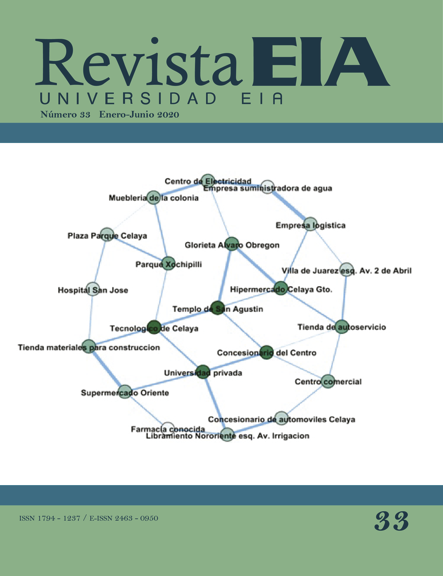Approach for profiling warehousing activity using customer's order data history.
Enfoque para perfilar la actividad de almacenamiento usando la información histórica de las órdenes de los clientes


This work is licensed under a Creative Commons Attribution-NonCommercial-NoDerivatives 4.0 International License.
Copyright statement
The authors exclusively assign to the Universidad EIA, with the power to assign to third parties, all the exploitation rights that derive from the works that are accepted for publication in the Revista EIA, as well as in any product derived from it and, in in particular, those of reproduction, distribution, public communication (including interactive making available) and transformation (including adaptation, modification and, where appropriate, translation), for all types of exploitation (by way of example and not limitation : in paper, electronic, online, computer or audiovisual format, as well as in any other format, even for promotional or advertising purposes and / or for the production of derivative products), for a worldwide territorial scope and for the entire duration of the rights provided for in the current published text of the Intellectual Property Law. This assignment will be made by the authors without the right to any type of remuneration or compensation.
Consequently, the author may not publish or disseminate the works that are selected for publication in the Revista EIA, neither totally nor partially, nor authorize their publication to third parties, without the prior express authorization, requested and granted in writing, from the Univeridad EIA.
Show authors biography
Article visits 519 | PDF visits 268
Downloads
- Accorsi, R., Manzini, R. and Maranesi, F. (2014) ‘A decision-support system for the design and management of warehousing systems’, Computers in Industry. Elsevier, 65(1), pp. 175–186.
- Agrawal, R., Imieliński, T. and Swami, A. (1993) ‘Mining association rules between sets of items in large databases’, in Acm sigmod record, pp. 207–216.
- Andres, B. (ed.) (2018) Encuesta Nacional Logística 2018. Available at: https://onl.dnp.gov.co/es/Publicaciones/SiteAssets/Paginas/Forms/AllItems/Informe de resultados Encuesta Nacional Logística 2018.pdf.
- Baker, P. and Canessa, M. (2009) ‘Warehouse design: A structured approach’, European Journal of Operational Research. Elsevier, 193(2), pp. 425–436.
- Bartholdi, J. J. and Hackman, S. T. (2008) Warehouse & Distribution Science: Release 0.89. Supply Chain and Logistics Institute.
- Chackelson, C., Errasti, A. and Tanco, M. (2011) ‘A World Class Order Picking Methodology: An Empirical Validation’, in IFIP International Conference on Advances in Production Management Systems, pp. 27–36.
- Chen, M.-C. et al. (2005) ‘Aggregation of orders in distribution centers using data mining’, Expert Systems with Applications. Elsevier, 28(3), pp. 453–460.
- Chuang, Y.-F., Lee, H.-T. and Lai, Y.-C. (2012) ‘Item-associated cluster assignment model on storage allocation problems’, Computers & industrial engineering. Elsevier, 63(4), pp. 1171–1177.
- Errasti, A. et al. (2011) ‘Diseño de un sistema de picking producto a operario. Aplicación del diseño de experimentos mediante simulación de eventos discretos.’, Dyna, 86(5), pp. 515–522.
- Frazelle, E. (2002a) Supply Chain Strategy : The Logistics of Supply Chain Management, The McGraw-Hill Companies. doi: 10.1036/0071418172.
- Frazelle, E. (2002b) World-Class Warehousing and Material Handling, New York. Edited by McGraw-Hill. McGraw-Hill.
- Van Gils, T. et al. (2018) ‘Designing efficient order picking systems by combining planning problems: State-of-the-art classification and review’, European Journal of Operational Research. Elsevier, 267(1), pp. 1–15.
- Goetschalckx, M. and Ashayeri, J. (1989) ‘Classification and design of order picking’, Logistics World. MCB UP Ltd, 2(2), pp. 99–106.
- Han, J., Pei, J. and Kamber, M. (2011) Data mining: concepts and techniques. Elsevier.
- Hsieh, L. and Tsai, L. (2006) ‘The optimum design of a warehouse system on order picking efficiency’, The International Journal of Advanced Manufacturing Technology. Springer, 28(5–6), pp. 626–637.
- De Koster, R., Le-Duc, T. and Roodbergen, K. J. (2007) ‘Design and control of warehouse order picking: A literature review’, European journal of operational research. Elsevier, 182(2), pp. 481–501.
- Park, B. C. (2011) ‘Order Picking Performance’, 대한산업공학회지, 37(4), pp. 271–278.
- Rouwenhorst, B. et al. (2000) ‘Warehouse design and control: Framework and literature review’, European Journal of Operational Research. Elsevier, 122(3), pp. 515–533.
- SPSS (2001) The SPSS TwoStep Cluster Component A scalable component enabling more efficient customer segmentation.
- Yener, F. and Yazgan, H. R. (2019) ‘Optimal warehouse design: Literature review and case study application’, Computers & Industrial Engineering. Elsevier, 129, pp. 1–13.




